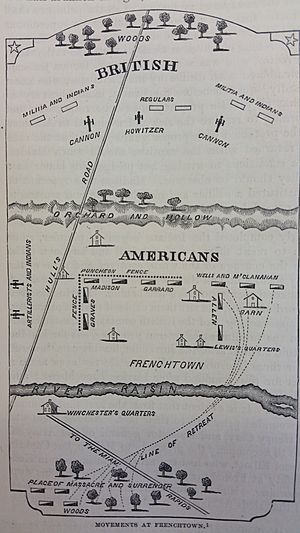Battle of Frenchtown facts for kids
Quick facts for kids Battle of Frenchtown |
|||||||
|---|---|---|---|---|---|---|---|
| Part of the War of 1812 | |||||||
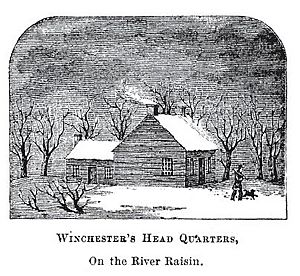 General Winchester's Headquarters on the River Raisin during the Battles of Frenchtown in 1813 |
|||||||
|
|||||||
| Belligerents | |||||||
Native Americans |
|||||||
| Commanders and leaders | |||||||
Roundhead Walk-in-the-Water |
|||||||
| Strength | |||||||
| 1,397 | 1,000 | ||||||
| Casualties and losses | |||||||
| 40 killed 162 wounded 3 captured |
410 killed 94+ wounded 547 captured (30-100 of whom were killed in ensuing massacre) |
||||||
| 30–100 killed in ensuing Native American massacre | |||||||
The Battles of Frenchtown were a series of fights during the War of 1812. They are also known as the Battle of the River Raisin or the River Raisin Massacre. These battles happened in Michigan Territory from January 18 to 23, 1813. The fighting was between the United States and a group of British soldiers and Native American allies. The battles took place near the River Raisin in Frenchtown, which is now Monroe.
On January 18, 1813, American soldiers pushed the British and their Native American allies out of Frenchtown. This was a smaller fight. It was part of a bigger American plan to take back Fort Detroit. The Americans had lost Fort Detroit the summer before. Even with this early success, the British and Native Americans fought back. They launched a surprise attack four days later on January 22. The American soldiers were not ready. They lost 397 soldiers in this second battle. Another 547 were taken prisoner. The next day, many wounded prisoners were killed by Native Americans. This event is known as the massacre. More prisoners died if they could not keep up on the march to Fort Malden. This was the deadliest battle ever fought in Michigan. It also had the highest number of Americans killed in one battle during the War of 1812.
Today, parts of the battlefield are a state historic park. They are also on the National Register of Historic Places. In 2009, Congress made it the River Raisin National Battlefield Park. It is one of only four such parks in the nation. It is the only one that remembers the War of 1812.
Contents
Understanding the Battle's Names
The Battle of Frenchtown happened in and around the Frenchtown Settlement. This settlement was started in 1784 on the River Raisin. The land where the battle took place is now part of Monroe. Some people use the name "Battle of Frenchtown" only for the main fight on January 22, 1813. They call the earlier fight on January 18 the "First Battle of the River Raisin." Or they just call it a warm-up to the bigger battle.
The full conflict from January 18 to 22 is sometimes called the "Battles of Frenchtown" (plural). While the fighting started on January 18, the heaviest part was on January 22. It might have continued for a few days after that. People often call it the "Battle of the River Raisin" because it was so close to the river.
The battle can be split into two parts:
- The First Battle of the River Raisin (January 18).
- The Second Battle of the River Raisin (January 22).
The name "River Raisin Massacre" is used for what happened on January 23. This was the day after the Americans surrendered. Pro-British Native Americans killed many wounded United States prisoners. These soldiers from Kentucky were too hurt to walk to Canada.
Why the Battle Happened
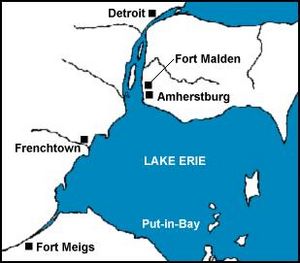
On August 17, 1812, General William Hull was in charge of the American Army of the Northwest. He gave up his troops and Fort Detroit to the British army. This happened after the Siege of Detroit. This early British success made many Native Americans decide to join the British side in the war. General Hull was later removed from the army. This was because of his actions at Detroit.
At that time, Fort Detroit was a very important military base. It was a possible starting point for any US attack into British Upper Canada. When the British captured Detroit, they gained a base. This helped them increase their power in the Michigan Territory. The local soldiers in Frenchtown also gave up their weapons. Frenchtown was only about 35 miles (56 km) south of Fort Detroit. Its people were defenseless against the British and Native Americans. They asked the Americans to fight back and push the invaders out.
After Hull was removed, General James Winchester took command of the Army of the Northwest. Instead of going north to take back Detroit, Winchester had a different plan. He became unpopular, so the command was given to General William Henry Harrison. Winchester stayed as second-in-command. Harrison's first plan was to march his men north and get Detroit back. To do this, he split the army into two groups. Harrison would lead one group, and Winchester would lead the other.
Meanwhile, General Henry Procter was in charge of the British army near Detroit. He gathered all available British troops. About 500 Native Americans joined them. These Native Americans were led by the Shawnee leader Tecumseh. Tecumseh was in the area during the Frenchtown fighting. However, he did not take part in the battle and left before the massacre.
First Battle of the River Raisin
| First Battle of the River Raisin | |||||||
|---|---|---|---|---|---|---|---|
| Part of the War of 1812 | |||||||
|
|||||||
| Belligerents | |||||||
Potawatomi natives |
|||||||
| Commanders and leaders | |||||||
| Ebenezer Reynolds | |||||||
| Strength | |||||||
|
200 Potawatomies |
600 Kentucky militiamen 100 French Americans |
||||||
| Casualties and losses | |||||||
|
1 Militiaman and 3 warriors killed or 1 Militiaman wounded, 15 warriors killed and two Militiamen and a warrior captured. |
13 killed 54 wounded | ||||||
General James Winchester was the second-in-command of the Army of the Northwest. He led about 1,000 soldiers. Most of these were new volunteers from Kentucky. General William Henry Harrison had told Winchester to stay close to Harrison's group. This was near the Maumee River in present-day Perrysburg, Ohio. That location was about 30 miles (48 km) south of Frenchtown. But Winchester did not follow orders. He sent a small group north to Frenchtown along the River Raisin.
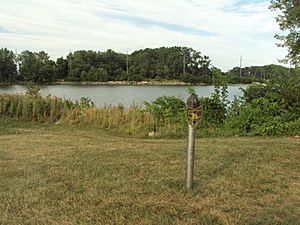
Lieutenant Colonel William Lewis led these men. They crossed the frozen Maumee River. Then they went along the shore of Lake Erie to the River Raisin. His force had 666 Kentuckians and about 100 local French-speaking Michigan soldiers. On January 18, 1813, Lewis attacked the British and Native American camp. This camp had 63 soldiers from the Essex Militia. They had one small cannon. About 200 Potawatomi were also there.
A quick battle took place. The Americans forced the British and their allies to leave. The Canadian soldiers attacked the American lines many times. Native American gunfire supported them. Fighting continued for several hours. The Canadians and Native Americans fought from log to log. After this, Lewis took back Frenchtown. One soldier said the Essex Militia "fought most bravely." They slowly moved back from log to log. This fight is known as one of the few times Canadian soldiers stood strong without British regular soldiers.
A Kentucky soldier named William Atherton wrote about the fight. He said the Essex men and Native Americans were very skilled at fighting in the woods. He wrote, "the fight now became very close, and extremely hot." He was shot in his right shoulder. Atherton saw two of his friends move too far forward. One was killed, and the other was wounded. Atherton described how the Canadians fought. They would quickly retreat out of sight in the woods. While the Americans moved forward, the Canadians would get ready to fire again. This meant the Americans often had to shoot at them as they were retreating.
Another Kentucky soldier remembered similar things. He said, "As we advanced they were firing themselves behind logs, trees, etc. to the best advantage." The Canadians and Native Americans slowly moved back over two miles of woods. Then they slipped away. They left Frenchtown to the Kentuckians. This fight became known as the First Battle of the River Raisin.
During their retreat from Frenchtown, the Potawatomi attacked Sandy Creek. This was a small town about 2 miles (3.2 km) north of the River Raisin. The Native Americans burned all 16 houses. They killed at least two people in the town. Sandy Creek was left empty and was never rebuilt.
Second Battle of the River Raisin
| Second Battle of the River Raisin | |||||||
|---|---|---|---|---|---|---|---|
| Part of the War of 1812 | |||||||
|
|||||||
| Belligerents | |||||||
Native Americans |
|||||||
| Commanders and leaders | |||||||
Roundhead Walk-in-the-Water |
|||||||
| Strength | |||||||
| 800 Native Americans 597 regulars and militia |
Approximately 1,000 | ||||||
| Casualties and losses | |||||||
| British 24 killed 161 wounded Native American Unknown |
397 killed 40+ wounded 547 captured (30-100 of whom were killed in ensuing massacre) |
||||||
After Frenchtown was taken back, General James Winchester and his troops joined Colonel Lewis. This happened two days later, on January 20, 1813. Winchester had acted without direct orders. But General William Henry Harrison was happy with Lewis's success. However, Harrison was worried. He thought the British forces might join together and defeat Winchester's small group. He ordered more men to go to Frenchtown. These included soldiers from the 17th U.S. Infantry and the 19th U.S. Infantry. He sent a message to Winchester. He told him to hold his position and get ready for more fighting.
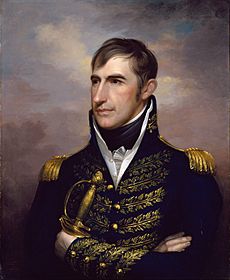
Winchester's soldiers were mostly new and not well trained. The First Battle of the River Raisin was the first fight for most of them. Events showed that Winchester's planning was poor. He had not made sure that ammunition and other supplies were brought from the Maumee River. The fence around the town had not been made stronger. Also, the regular soldiers were camped outside the town's walls. A few days after the first fight, local people told Winchester that a large British force was coming. Winchester ignored them. He said it would be "some days" before the British would be ready to attack. His troops were camped all over Frenchtown. Winchester went to his headquarters for the night. This was at the Navarre House south of town. He did not make sure guards were in place.
When General Henry Procter heard that the Americans had taken Frenchtown, he acted. Procter was the British commander near Detroit. He marched his troops from Fort Malden. They crossed the frozen Detroit River from Upper Canada. His army had 597 regular soldiers. These were from the 41st Regiment of Foot and Royal Newfoundland Fencibles. About 800 Native Americans joined them. This force met up with parts of the Essex militia. These soldiers had retreated after their first defeat on January 18.
The Shawnee leader Tecumseh was in the area. But he was not at the Battle of Frenchtown. He left the Native Americans under the command of Wyandot chiefs Roundhead and Walk-in-the-Water. The Native American groups included Shawnee, Potawatomi, Ottawa, Chippewa, Delaware, Miami, Winnebago, Creek, Sauk, and Fox tribes. Procter had six small cannons. These were pulled on sleds. Men from the Canadian Provincial Marine operated them. Procter stopped about 5 miles (8 km) north of the River Raisin. He got ready for battle on January 21.
Procter surprised the American forces before sunrise on January 22. A Canadian volunteer, John Richardson, was with the British soldiers. He later wrote, "On the 22nd, before daybreak, came within sight of the enemy." He added that the Americans were so careless that the British were "half formed within musket shot of their defenses before they were even aware of our presence."
The American regular soldiers only held their ground for twenty minutes. These four companies of soldiers were mostly new recruits. They were caught out in the open. They faced heavy gunfire from the front. They were also under direct cannon fire from the six small cannons. The Essex militia and Native Americans attacked their sides. The regular soldiers broke and ran. General Winchester woke up because of the cannon fire. He rushed to the battlefield. He ordered 240 men to help the regular soldiers. These men were from the 1st Kentucky Rifle Regiment. But they could not even reach them.
Under fire from three sides, the Americans ran away toward Ohio. They tried to gather three times. But they were eventually surrounded on a narrow road. Almost 220 of the 400 Americans were killed. 147 men, including Winchester, were captured. The Native Americans and Canadian soldiers captured them. Chief Roundhead took Winchester's uniform before giving him to the British. This led to a story that Winchester was captured in his nightshirt. The remaining Americans were spread out and could not fight. The colonel of the 17th's, John Allen, was shot and killed. Many soldiers gave up their weapons. But they were still killed by the Native Americans. Men from other groups also tried to run away. Most were caught and killed. A few escaped by taking off their shoes. They ran in their stockings. Their footprints in the snow looked like moccasins. So, they were not followed. British troops took over a large barn. William Orlando Butler set it on fire. This was to force any hidden Americans out.
However, the 1st and 5th Kentucky Rifle Regiments and the 1st Volunteers kept fighting in Frenchtown. They lost 5 killed and 40 wounded. But they had caused a lot of damage to the British cannons. Their skilled shooters had killed or wounded almost all the men operating the three cannons in the middle of the British line. They also hit 13 of the 16 men on the howitzer crew. They had also shot many British soldiers. But now, they were running out of ammunition. They had fought off three British attacks.
General Procter demanded that Winchester order his remaining men to surrender. Otherwise, he said everyone would be killed and Frenchtown burned. Procter wanted a surrender with no conditions. He refused Winchester's ideas, since Winchester was already his prisoner. Major George Madison, an American officer still on the battlefield, convinced Procter to accept a surrender. Procter promised that all would be protected as prisoners of war.
When the Kentucky soldiers saw the British waving a white flag, they thought it meant a truce. Instead, a British officer gave them a written order from General Winchester to surrender. They refused. They decided to fight until death rather than trust the Native Americans. After three more hours of fighting, Major Madison officially surrendered.
Procter tried several times to get the Native Americans to burn Frenchtown. But the Potawatomi refused. They had given the land to the settlers. They did not want to hurt them more.
The River Raisin Massacre

Right after the Americans surrendered, some Kentuckians argued with their officers. They said they "would rather die on the field" than give up. They were afraid their captors would kill them. Still, the fighting stopped right after they surrendered. About 300 Americans were killed. Over 500 were taken prisoner. Procter decided to leave quickly. He was worried that General Harrison would send more troops. Procter marched the uninjured prisoners north. They crossed the frozen Detroit River to Fort Malden. The wounded prisoners who could not walk were left behind in Frenchtown. Procter could have waited another day for sleds to carry the wounded. But he was worried more American soldiers were coming from the south.
On the morning of January 23, the Native Americans started robbing the injured Americans in Frenchtown. Any prisoner who could walk was marched toward Fort Malden. Those who were more seriously hurt were left behind. The Native Americans killed them. The Native Americans also set fire to the buildings where the wounded were. Prisoners who escaped the burning buildings were killed. As the Potawatomi marched prisoners north toward Detroit, they killed anyone who could not keep up. Estimates of how many wounded were killed by Native Americans range from 30 to as many as 100.
The killing of the American wounded on January 23 became known as the River Raisin Massacre. It shocked Americans. News of the massacre spread across the country. The massacre was very hard for the state of Kentucky. Most of the soldiers for the campaign came from Kentucky. Kentucky lost many important people in either the battle or the massacre. The cry "Remember the River Raisin!" or "Remember the Raisin!" made many more Kentuckians join the war.
What Happened Next
We don't know exactly how many soldiers died during the First Battle of the River Raisin on January 18, 1813. But a record called Eaton's Compilation says 397 Americans were killed and 27 wounded on January 22. Also, the number of people killed during the River Raisin Massacre is not fully known. Estimates go as high as 100 killed. Two weeks after the battle, General James Winchester reported that 547 of his men were taken prisoner. Only 33 escaped the battlefield. Winchester was held prisoner for over a year. Then he was released and went back to military service.
James Winchester was mostly responsible for the big loss at Frenchtown. His poor planning after the successful First Battle of the River Raisin led to his army's defeat. It also caused many deaths. If Winchester had gone back to the Maumee River to join General Harrison's group, they could have made their army stronger. Then they could have marched back to Frenchtown with enough troops and been ready to fight. Instead, Winchester stayed in Frenchtown with his small force. He knew a British and Native American attack was coming. He did not know that Harrison's troops were on their way and would arrive soon. During the Second Battle of the River Raisin, Winchester was captured early. He surrendered his army when General Henry Procter urged him to.
Winchester's army lost many men at the start of the surprise attack. But the Kentuckians regrouped. They fought off three waves of British attacks to protect their camp. They were very low on ammunition when Winchester's order to surrender came. If the Americans had fought longer, Harrison's group might have arrived. This could have changed the battle's outcome.
The British reported 24 killed and 161 wounded. The number of Native American casualties is not known. Right after the battle, Procter was afraid General Harrison would send more Americans to Frenchtown. So, he quickly retreated a bit north to Brownstown. Harrison had to cancel his plans to take back Detroit that winter. The British held Detroit until the United States won the Battle of Lake Erie on September 10, 1813. This allowed Detroit to be taken back. Frenchtown was a British stronghold until Colonel Richard Mentor Johnson from Kentucky freed the town on September 27, 1813. The British were pushed back into Upper Canada. They were defeated at the Battle of the Thames on October 5.
Remembering the Battle
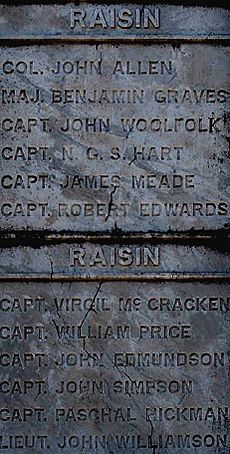
Nine counties in Kentucky were later named after officers who fought in the Battle of Frenchtown. Of this list, Bland Ballard was the only one to survive.
- Allen County (after Lieutenant Colonel John Allen)
- Ballard County (after Major Bland Ballard)
- Edmonson County (after Captain John Edmonson)
- Graves County (after Major Benjamin Franklin Graves)
- Hart County (after Captain Nathaniel G. S. Hart)
- Hickman County (after Captain Paschal Hickman)
- McCracken County (after Captain Virgil McCracken)
- Meade County (after Captain James M. Meade)
- Simpson County (after Captain John Simpson)
Several streets in Monroe, Michigan near the battle site are named to remember those who fought. These include Kentucky Avenue and Winchester Street. Also, the state of Michigan put up a monument in downtown Monroe in 1904. The monument is on the west side of South Monroe Street (M-125) at 7th Street. The unknown remains of some battle victims are buried there.
The main area where the battle happened was named a Michigan Historic Site on February 18, 1956. This area is bordered by North Dixie Highway, the River Raisin, Detroit Avenue, and Mason Run Creek.
The site was recognized nationally on December 10, 1982. It was added to the National Register of Historic Places. The River Raisin National Battlefield Park was approved on March 30, 2009. It was funded later that year. It is one of four National Battlefield Parks in the United States. It is the only one that remembers the War of 1812.
Images for kids
-
An obelisk, located on the battlefield grounds, commemorates the victims of the Battle of Frenchtown.
-
Located in downtown Monroe, the monument commemorates Kentuckians who died during the battle.


